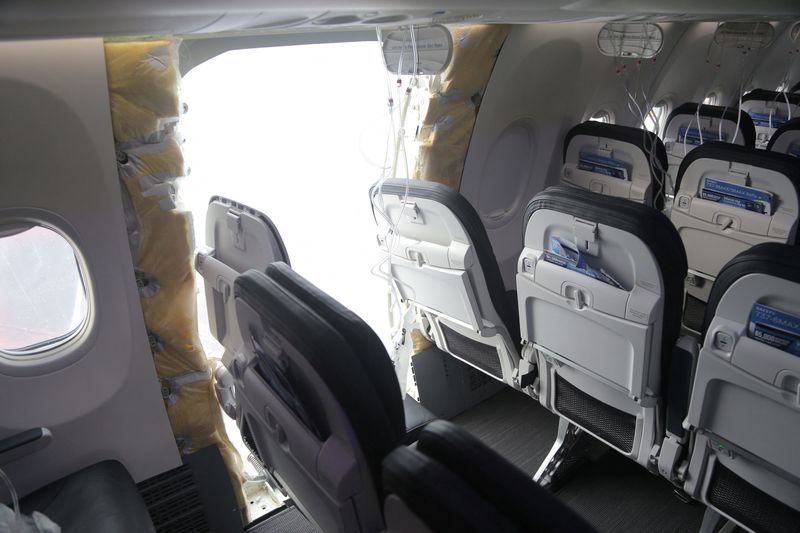(Reuters) - A door panel that flew off a Boeing (NYSE:BA) 737 MAX 9 jet mid-flight on Jan. 5 appeared to be missing four key bolts, according to a preliminary report from U.S. investigators that provided the first official look into how the frightening mishap took shape.
The fuselage tore off the left side of an Alaska Airlines flight shortly after taking off from Portland, Oregon. It left a gaping hole in the side of the plane while in mid-air, and forced a dramatic emergency landing.
The panel is a plug in place on some 737 MAX 9s instead of an additional emergency exit. Regulators grounded 171 planes for several weeks so airlines could inspect those crafts. Here is an explainer on that panel.
WHAT HAPPENED?
As Alaska Air (NYSE:ALK) Flight 1282 reached just over 16,000 feet (4.88 km) on Jan. 5, the panel tore off from the side of the jet, leaving a refrigerator-sized, rectangular hole in the aircraft. The door plug was later discovered by a Portland school teacher who found it in his backyard.
WHY IS THIS PANEL THERE?
The 737 MAX 9, currently Boeing's largest single-aisle plane in production, can seat up to 220 people. It includes an optional extra door to allow for the approved number of evacuation paths whenever carriers opt to install more than 189 seats.
Planes that do not opt for additional seating can replace that door with a panel, or plug. Door plugs have been used to adapt aircraft and offer flexible layouts across the industry for years.
Certain models of Airbus jetliners also feature door plugs, but the European planemaker uses a different design, people close to the company said.
HOW IS THE DOOR PLUG HELD IN PLACE?
A diagram of the 737 MAX 9 door plug posted by the U.S. National Transportation Safety Board shows the plug held down by four bolts: two in the upper corners and two lower hinge brackets. The diagram also shows two straps and two bonding jumpers near the bolts.
The plug is further secured by "stop fittings" at 12 different locations along the side of the plug and the door frame. The fittings hold the plug in place, preventing it from being pushed out of the airframe.
The plug measures 26 by 48 inches (66 by 122 cm) and weighs 63 pounds (29 kg).
WHAT ISSUES AROSE DURING PRODUCTION OF THIS PANEL?
All 12 of the stop fittings became disengaged during the event, and the guide tracks on the plug were fractured as well. Photo evidence released on Tuesday shows bolts were missing from the door plug, which had been removed to fix rivets that were damaged in the production process, according to the NTSB report.
The door plug in question arrived in Boeing's Renton, Washington, plant on Aug. 31. A record created on Sept. 1 showed damage to the rivets on the plug's frame, the NTSB report says. Four bolts had to be removed to repair the damage, and a photo in the report shows three visible locations where bolts are missing, with the fourth location covered by insulation.
"Photo documentation obtained from Boeing shows evidence of the left-hand MED plug closed with no retention hardware (bolts) in the three visible locations," the report says. MED is short for "mid exit door."
WHO MAKES THIS PANEL?

The fuselage for the Boeing 737 is made by Kansas-based Spirit AeroSystems (NYSE:SPR), which separated from Boeing in 2005. Spirit is one of two suppliers that make the plug doors on the MAX 9, but Boeing also has a key role in the plug installation process.
Spirit builds fuselages for 737s and sends them to Boeing's Renton, Washington, plant. There, the hull is pressurized to 150% to make sure everything is working correctly.